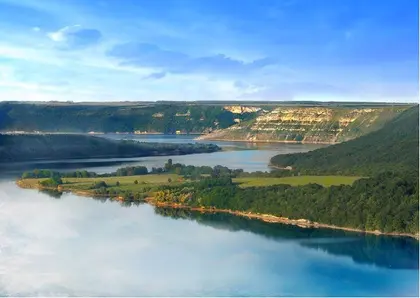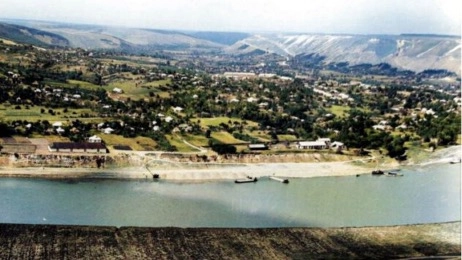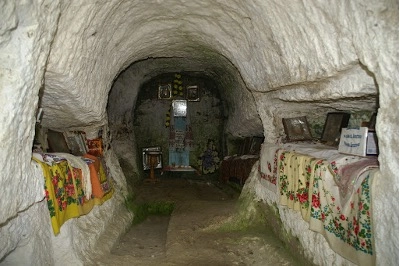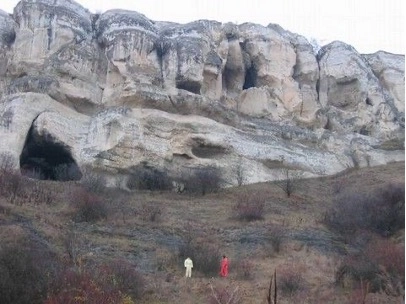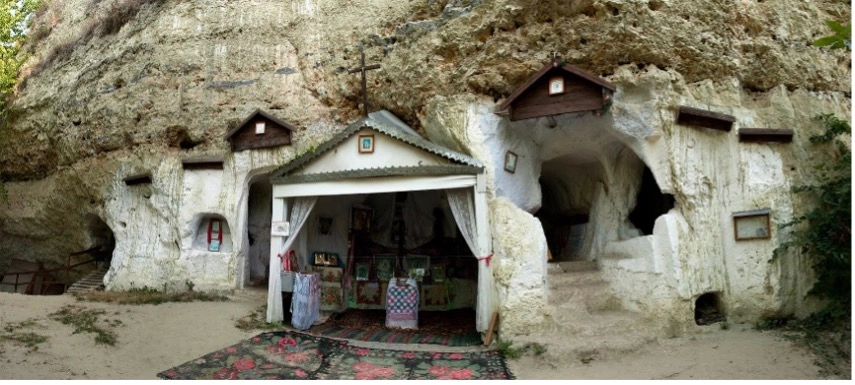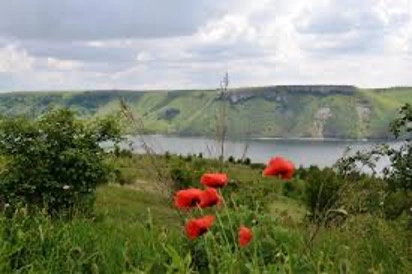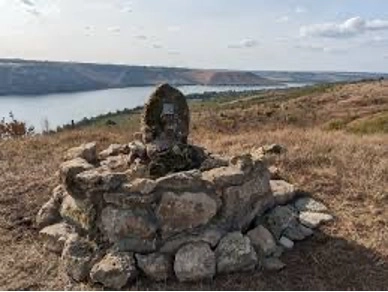A most interesting and even mysterious place lies on the picturesque steep bank of the Dniester River in the Khmelnitsky region, western Ukraine. It is called Bakota, the name of the ancient town that flourished from the early 12th to the mid-15th century, when it was then destroyed by Poles. Later, a small village remained, but it was completely inundated when the Dniester Hydropower Station was built in 1981.
The name “Bakota” comes from Old Slavic, meaning “a beautiful, coveted place”. Archeological findings prove that the area along the right bank of the Dniester used to be quite densely populated, with numerous pagan heathens and burial mounds. Female remains found there suggest they date back to the matriarchate period.
The town of Bakota was an important administrative and trading center that occupied an area of approximately 10 hectares. It had a population of about 2,500, which was quite substantial for those times. It was first mentioned in a chronicle dated 1240, the year the Mongol-Tatar hordes led by Khan Batu seized Kyiv and advanced further west and southwestwards. Bakota was the last town in Kyivan Rus seized by the Mongol-Tatars. Had they crossed the Dniester, they could have invaded far more of Eastern and Central Europe.
In 1431, when Poland and Lithuania declared a truce, Bakota became a no man’s land, and soon afterwards its residents revolted. They killed all their landlords and proclaimed independence, although this did not last long. Three years later, Polish troops cruelly suppressed the rebellion: they executed the leaders, burned down the houses, destroyed the castle and drove all the townsfolk away. Bakota ceased to be a town and was, for several centuries that followed, just a small, quiet village.

Portrait of a Book Fair in War Time
A rare case in Ukrainian history, Bakota was left intact by World War I and the turbulent revolutionary events that followed, the Holodomor of 1932-1933 and the battles of World War II that somehow passed it by. The only thing that changed the village's appearance was a seven-foot-high stone wall built along the riverbank after 1918, when Bakota became a frontier village on the Romanian border that ran along the Dniester.
After another devastating famine hit Ukraine in 1947, Bakota’s population shrank threefold, but during the 1960s and 1970s, the village grew and became known countrywide as a popular resort. It also served as a filming location for a number of movies.
Its history ended in 1981, when a hydropower plant was built on the Dniester. The last of the residents were resettled to the neighboring villages and towns before the village of Bakota found itself in the water.
Bakota village before inundation, 1980
That is all there is to the history of Bakota as a populated locality, but not as a historical site and popular tourist destination. That is mostly thanks to its famous St. Michael’s Rock Monastery built inside the solid limestone wall of the Dniester bank.
Christian monks
The monastery was founded by Reverand Antonius in the early 1030s, almost two decades before he dug the first cave in Kyiv in 1051, founding the Kyiv-Pechersk Monastery.
Icon of Rev. Antonius, 1073
It is known that Christian monks had settled in a cave in the steep wall of the Dniester bank. They cut their cells in the limestone at least two centuries earlier, in the 9th century AD, so the rock monastery of Bakota may be one of the oldest in Eastern Europe.
St. Michael’s Rock Monastery was first mentioned in the Kyiv Book of 1362 as “very old.” The monks made an altar near one of the walls and the relief of the stone resembled a holy image. Later, local masters painted an icon upon it, but the paint inexplicably vanished within a matter of days. And it vanished every time the image was painted.
The monks built a wonderful church, actually cutting it into the rock. The church had a special wooden gate, and hollows for the hinges can still be seen there. The floor was wooden and in winter the church was heated.
Interior of the cave church
Somewhere in the middle part of the slope, some 240 feet above the river, one can see the stone wall of a precipice and a narrow path that leads to it. A whole cave town is hidden in that vertical limestone cliff. There certainly must have been a direct connection between the upper and lower parts and the monks may have used ladders or stone juts.
Caves in the limestone wall
The main premises of the monastery were cells and three caves, each measuring about 30 feet long and some nine feet high.
One of the caves holds all the remains of the monks that were found during excavations.
Monks cut niches in the walls of the caves and spent days and nights lying there. When they died, they were buried in those niches and covered with stones.
When the human bones were found, all of them lay there anatomically.
Entrance to St. Michael's monastery
Refusal to surrender
In 1255, when Mongol-Tatars broke into the town, the monks and all residents of the town hid away in the labyrinth of monastery caves. The invaders promised to spare them if they surrendered and relinquished their faith. The proud monks and townsfolk refused, so the invaders heaped up large rocks to block the cave mouth, burying all the people alive.
After the Mongol-Tatar invasion, the monastery was rebuilt and prayers again sounded there for several centuries.
In 1996, the top part of the White Rock collapsed, destroying most of the caves and the burial vault with ancient frescoes and wall paintings dating between the 11th and 13th centuries. All that was left of the ancient monastery was a few cells and graves, ruins of St. Michael’s Church, and an abandoned orchard.
Positive lasting energy
Meteorologists maintain that the quantity of heat per square foot in Bakota is equal to that in Yalta, the Crimean seaside resort. They explain this phenomenon by a unique microclimate: high rocks and forests protect the area from cold winds.
And biophysicists have found that the site of the Bakota monastery has an incredibly powerful charge of positive energy. Its walls must have heard so many prayers that they seem to be breathing with some power of vitality.
Many people know about the megaliths in Bretagne or Corsica, but very few know that there are similar sites in Ukraine. Bakota is one of them. There is a huge dolmen – 13 feet in diameter and two feet thick – near the caves.
The place is popularly called “Ukrainian Stonehenge”, but unlike the English structure, which is believed to have been some kind of ancient observatory, this must have been a real altar stone from ancient legends.
The stone weighs several tons and rests on three smaller stones, and it is simply incomprehensible how it was put on top. The structure of the dolmen differs from the local rock. Researchers who have recently put a sample of it under chemical analysis claim it is identical to the rock found on Sinai. But how did it get to Bakota then?
There is a crosscut on the surface of the stone. Near it are seven hollows representing an inversed image of the Great Bear. On major holidays, people fill the cross with water. On other days, rain never leaves it dry and its bottom has the color of blood.
People believe that the water in the cross is healing. Nobody knows why the cross-shaped hollow was made exactly in this place of the dolmen. It may have been a font in which newborns were baptized. Or it may have been the place where the first Christians made bloodless sacrifices to the Lord.
For centuries, this incredible thing served as an altar to pagans and Christians. Near this dolmen, time seems to flow three times slower. This place is made for praying, and it seems like our forefathers – pagans and Christians alike – are staring at us with anxious eyes.
Monument to inundated villages
The silence in the cave strangely harmonizes with the singing of birds outside. And even the human skulls do not look at all frightening. They just make one wonder who each man was, what he dreamt of, or what kind of life he led. He may have been an icon painter, or a monk who took a vow of silence, or even Father Superior. The walls of the cave sound hollow, which means there are cavities and more secrets. Some of the answers are hidden in the rocks and on the bed of the Dniester River.
You can also highlight the text and press Ctrl + Enter


